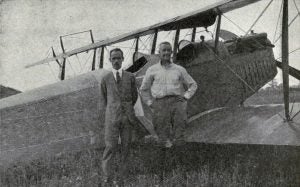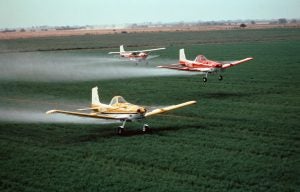I was working out in my garden last summer when a bright yellow airplane started flying overhead. My subdivision, which used to be a strawberry patch, is surrounded by corn and soybean fields. I watched as the plane would sweep across the nearby field, precisely spraying the corn crop before turning around low over my house. I immediately turned into a little kid and watched the whole production with fascination.
Believe it or not, this August marks the 100th anniversary of agricultural aviation.
An account of that first test flight is retold in Agricultural Aviation’s Spring 2021 issue. Back in 1921, modern pesticides were in their infancy. Farmers struggled to find reliable and effective pesticides. And even if they could, applying those pesticides was nearly impossible. Hand spraying was an option, but one person could cover only about 8 acres of crops per year. Some horse or mule-driven pumps and sprayers were available. But even covering 125 acres a year meant large farms required multiple units, something that wasn’t always feasible.
So how could the process be improved? C.R. Nellie, an entomologist, had an idea: maybe airplanes could help. He teamed up with J.S. House, also an entomologist, and the Ohio Agricultural Experiment Station to run the first-ever aerial spraying experiment.

Although the idea was ridiculed at the time, Nellie and House were determined. They selected the retired military biplane trainer known as the Curtiss JN-6, chosen because it’s speeds topped out at 90 mph. They tapped Lt. John A. Macready, a U.S. Army pilot who would go on to win numerous awards for a distinguished career, to man the plane. The plane itself was equipped with a specially-made metal hopper by Etienne Dormoy. The hopper housed the insecticide and included a door that a passenger in the plane could open to release the insecticide over the field. The target was the sphinx moth larvae, which was busy attacking catalpa trees in the region.
The experiment was a resounding success. The airplane covered the trees in 175 pounds of insecticide in about 54 seconds of actual dusting. It was a world record for applying pesticides to a forest area. After six days, only one-percent of the larvae remained on the trees.
Things moved quickly after that, and just in time. Boll weevils were absolutely decimating cotton fields in the American South. The U.S. Department of Agriculture’s Bureau of Crop Estimates figured the economic losses from boll weevils were about $300 million annually (that’s the equivalent of close to $4 billion in 2020). Although scientists had developed an effective insecticide to control the pests, application was a problem. So in 1922, aerial application was first used on cotton fields near Tallulah, Louisiana.
Over the next hundred years, agricultural aviation continued to progress to keep up with farm innovation. Today’s applicators use GPS and GIS mapping to apply pesticides on fields with the precision and accuracy required. Its scope has also expanded; it’s used to apply fertilizer, lay cover crops, and even fight wildfires. Although farmers have other options for spraying these days, crop dusting is still every bit as revolutionary as it was in the 1920s.

“Farming in the 21st century is a complex balance of maximizing yields while protecting the environment and preserving overall sustainability,” Andrew Moore, CEO of the National Agricultural Aviation Association, said in a news release marking the anniversary. “Aerial applicators’ efficiency and ability to apply fertilizer or attack pests at just the right time play a key role in helping farmers meet those demands.”
I imagine Nellie and House shared some of my own excitement watching that first test flight. They had to know that crop dusting could literally change agriculture. But I wonder if they realized just how important it would become, or how many problems it may solve, even 100 years later.
Amanda Zaluckyj blogs under the name The Farmer’s Daughter USA. Her goal is to promote farmers and tackle the misinformation swirling around the U.S. food industry.



